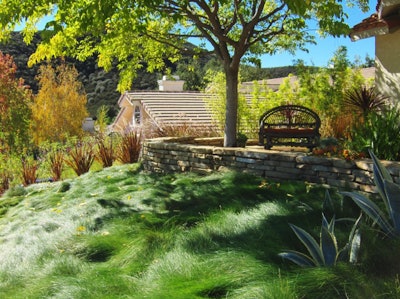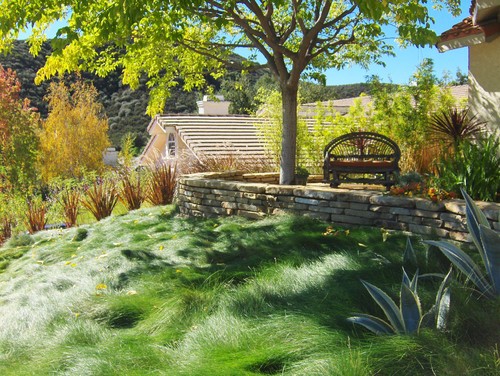
There are a number of species and varieties of fine fescue grass that may differ in color, leaf texture, disease resistance, shade tolerance, and drought tolerance.
There are four main species that are known as fine fescues due to their narrow leaf blades, but each has different preferences.
Chewings fescue is named after George Chewings who discovered and first sold this grass. It prefers the north/central U.S. It has a high tolerance for the shade, but it does not do well in wet soils.
Hard fescue has a gray/green color similar to buffalo grass. It prefers northern climates with drier soils. It is growing in popularity thanks to its ability to tolerate heat better than some other fine fescues.
Sheep fescue is ideal for areas that are shaded and will receive little maintenance, like steep shaded hillsides. It can also blend well with wildflowers without crowding them out.
Creeping red fescue prefers cool, damp climates. It does not do well in the sun and this variety can also develop a thick layer of thatch. Slender creeping red fescue is similar to creeping red fescue, but it does not grow or spread as rapidly.
Chewings, hard, and sheep fescue are bunch-type grasses, while creeping red fescue is a rhizomatous type.
Fine fescues are drought-resistant, but they will go dormant, turning brown until irrigation or rainfall resumes. They will also become dormant if exposed to temperatures above 90 degrees Fahrenheit for an extended amount of time. This cool-season grass is also notably tolerant of salt.
Maintenance needs
Fine fescues are particularly low maintenance when it comes to the care they need to thrive.
With mowing, this cool-season grass can be mowed as low as 1.5 inches, but it’s better to leave it higher, usually around 3 to 4 inches. Bigler adds that if the area is shaded, the mowing height should be on the upper end of the range.
As for watering, fine fescue prefers drier soils, but without regular irrigation, the grass will go dormant.
It also has low fertilizer needs, with about 1 to 2 lbs. of nitrogen per 1,000 sq. ft. needed per year. If the grass is left un-mown, it should only be fertilized once a year in the fall.
Fescue lawns lacking in nitrogen will appear yellowish to light green, with a thin appearance. However, applying too much will hurt the turfgrass’s ability to tolerate temperature extremes, foot traffic, and drought.
Common problems to watch for
Some of the diseases that are most likely to be a problem for fine fescue are red thread, brown patch, and dollar spot.
Red thread is common in humid, damp, cool spring weather. Meanwhile, brown patch is more likely to appear in warm, moist climatic conditions.
If nitrogen levels are too low, dollar spot can appear, so the best method to deal with this fungal disease is to correct the nitrogen levels. Dollar spot is recognizable by tiny yellow spots on individual blades and as the grass dies, straw-colored spots 2 to 3 inches in diameter begin to appear in the lawn.
Thick thatch is a common problem that can occur as a fine fescue lawn matures. If left to accumulate, a layer of thatch can prevent water, nutrients, and air from reaching the soil. Thatch can be removed with rakes, a vertical mower, or a dethatching mower.
Dethatching fescues is advised in the early fall or spring when cool, moist weather is likely.
Common mistakes to avoid
While fine fescue can tolerate drought conditions and salt exposure, it does not handle foot traffic well. It can recover from the wear and tear, but it takes time to do so since shade grasses grow slower than those in the sun.
Putting it in un-adapted areas, especially areas that require higher levels of maintenance to achieve a desired visual performance, is a mistake.
It’s also important to realize that just because fine fescue does better in the shade than most turfgrasses, doesn’t mean it can thrive in impenetrable shade.
Industry experts say that while fine fescues are more shade tolerant, in dense shade areas, it is difficult to keep a robust stand of turf regardless of the shade tolerance.
Fine fescues also tend to be more sensitive to herbicides than other cool-season grasses so make sure to check the label for proper rates for fescue lawns.










